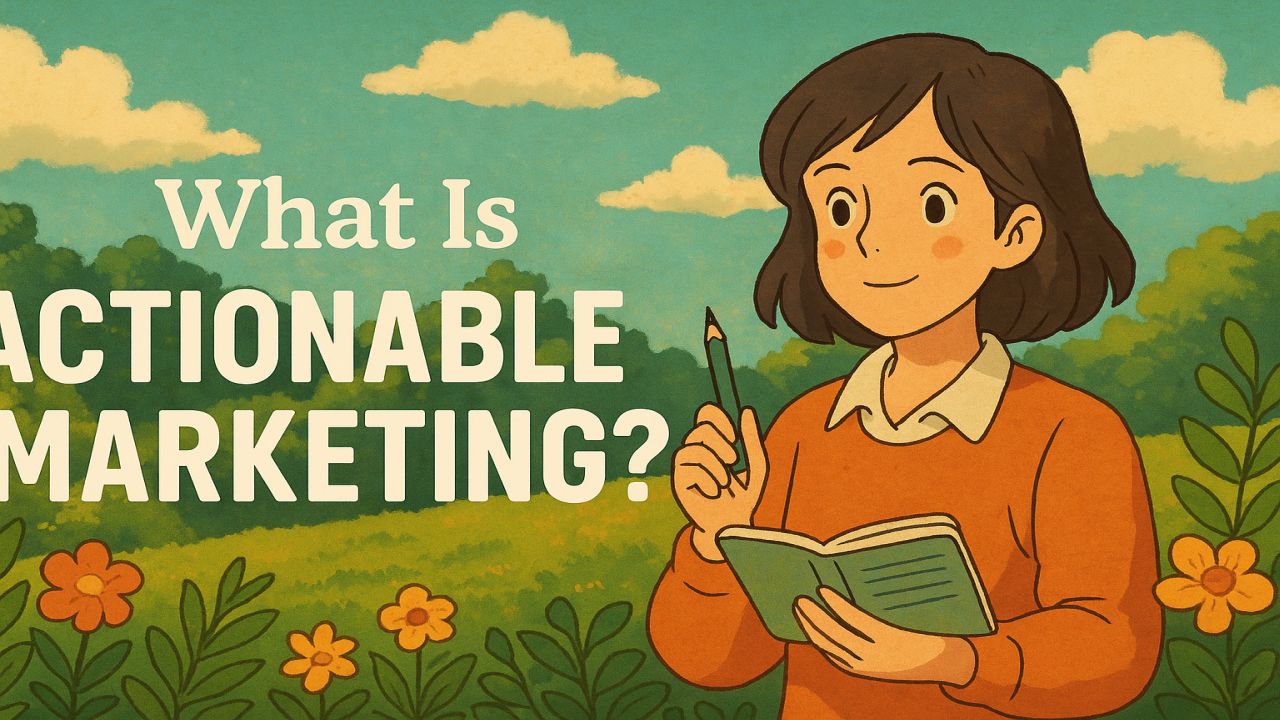Actionable marketing is a method of getting your customers to engage with you by building trust and relationships. It’s both branding and direct marketing over different platforms and devices that offer real value to both business and customer. You should be aiming for more engagement, conversions, and better responses by being more in touch with …
Actionable marketing is a method of getting your customers to engage with you by building trust and relationships. It’s both branding and direct marketing over different platforms and devices that offer real value to both business and customer.
You should be aiming for more engagement, conversions, and better responses by being more in touch with your customer via persuasive communication and using methods that don’t appear clumsy, greedy, or hard-selling.
1. Upselling Products
It’s easier to sell more units to the customers you’ve already got than to find new ones.
Upselling is your best friend. You’ve already as good as made the sale, so just before your customer makes their purchase, offer them something extra. It might be the next model up in the range or more of those products at a lower rate. What about some earrings that go with the necklace they’ve just bought? Don’t miss a simple opportunity to sell a little bit more than your customer had originally decided to buy.
To keep selling to your existing customers, you have to make sure you retain their loyalty. And that’s important in actionable marketing. You have to make them feel like they belong to your brand, that they’re part of your brand family.
2. Optimize Your Product Pages
Write to your typical customer, and if you don’t know who they are, then you absolutely need to find out. Actionable marketing is about building a relationship with your customers, so if you don’t know who they are or what type of person buys your product then work out how you can.
Your visitors don’t just want to see your products and read relating information they want to be dazzled. Make sure your product imagery is high quality and professional. Write clear and crisp, fun and informative text that appeals to your typical customer. Sell them the lifestyle that your product will bring them not the product itself. Don’t just tell them how much better life will be with your product, but why.
3. Use Social Media Properly
You are constantly told to use social media in marketing (and you definitely should!), but you also need to know how to use it in the best ways possible for your business. For some brands, it’s as simple as keeping their masses of followers brand engaged so they remember to make a purchase from time to time. For others, it’s about driving exclusives and offers to boost sales when they’re quiet.
You need to make sure you understand how social media works best for you and be considering those means to drive fresh traffic to your website or to make sales from within that page.
Instagram offers methods to sell directly from your posts by adding your products.
On Facebook, you can build a store where customers can buy from you without leaving the app.
And never forget the importance of paid advertising available on social media platforms. It’s not only a great way to drive sales and traffic but a good method of gathering data about your customers.
4. Lower Your Abandoned Cart Rate
Did you know that the abandoned cart rate is 69.23%?
That’s a phenomenal amount of sales you could be failing to convert. Why do buyers jump out of the buying process on their way through your checkout process? Well, consider the following and see if you’re guilty of any. If you are, then fix them, fast.
Are you adding unseen costs that boost the total spend? Additional costs or fees (e.g.: shipping, etc.) that take the total spend out of the customers desired price range are responsible for the greatest percentage of abandoned carts.
Do you make customers create an account? Customers want a fast and simple process; a laborious account set up can be enough to stop some buyers mid-process.
Too complicated a checkout process. If you’re guilty of this, then shame on you. Simplify. So much of online selling is about user experience after all.
Missing information about costs. Many customers want to know the full cost before entering the checkout process. If they can’t find the additional costs they’re looking for they may well disappear to an alternate seller who’s more transparent.
Lack of payment trust or gateway methods. If your website isn’t or doesn’t appear secure or trustworthy then buyers won’t feel safe entering a transaction. And if you only offer payment options that not all buyers have access to, once again, you’re limiting your opportunities.
There are many more here but you get the point. Troubleshoot for errors, the speed of transactions, delivery of information and more. Tighten up your lead flow metrics so you don’t lose a sale that should have already be in the bag.
5. Optimize Your Email Campaigns
You should be gathering data to deliver follow-up emails and targeted sales with regular and informative messages that your customers will want to receive.
Use your email campaigns to educate buyers of additional ways to use the new products that they might not have considered, and don’t forget to remind them how much it will improve their lifestyle. You should be educating them in the ways you behave as a business that will make them proud to own your products. Use that information to build relationships. Customer loyalty is key in actionable marketing.
You should be using this direct method to offer promotions or discounts that aren’t available anywhere else. This will impart that sense of belonging already mentioned.
And don’t be afraid to ask for feedback. Some customers love filling in a good form to kill a little time, others will drop it straight in the trash, but at least you’ll garner some useful data from the percentage that do. Consider using geographic information to improve your local link building strategies or their average online spend to choose which are the most appropriate products to push.
6. Try Live Chat
You’ve seen the pop-up chat boxes, and you may be on the fence whether they’re a good idea or not but we’re telling you, YES THEY ARE! If a customer is willing to chat with you or has unanswered questions then that’s a premium opportunity to help guide the sale. Don’t be pushy, that’s not the face of your brand, is it? Just be helpful and hopefully, you’ll see the benefit of your handholding in increased conversions.
7. Optimize Your Online Advertising
Again, if you know who your typical customer is you can optimize your online advertising to match. Pay per click and social media paid to advertise each include breakdowns of the key demographics that you’re free to pick and choose between so don’t just guess, make your choices from what you’ve learned from your existing data. Are your customers male or female? Old or young? Where are they based? Where do they hang out online? And if you don’t know these things then find a way to. Set up conversion tracking in any advertising you’re already utilizing, and if you aren’t, then start, and find out the information that you’re missing.
Also, why not send a short questionnaire after you’ve made a sale that offers an incentive? Give away a voucher or a discount code for the return of information that you can use to understand exactly how to drive your ad campaigns.
8. Use Ad Extensions And Sellers How-to Guides
The ad extensions utilized in Google Ads and on Bing (and any others I haven’t mentioned) should be a no-brainer for driving traffic to customer specific areas and actioning marketing that goes directly to helping your customers find you and engage with you.
The simpler the process from search to spend the better chance you have of conversion to make it easier for them to phone, buy, browse, or find a specific category or product line; they’re all things you can do to help your buyers skip through what they don’t want and go straight to buying what they do.
If you’re an agent or a seller using alternative marketplaces such as Etsy, eBay or ‘Not on the Highstreet’, then follow their guides in how to create smoother and stronger sales patterns and also in how to enhance your conversions. Given how much they want you to succeed, using Amazon marketing services or any other platform guide should be standard for any vendor.
9. Reward Loyalty
It amazes me how many businesses are willing to sacrifice existing sales by creating poor relationships when excluding existing customers. How many times have you seen introductory offers to new customers that aren’t available to the existing ones? Changing bank account, TV or electricity suppliers can be done with a few button clicks now and we’re encouraged more than ever to seek out the best deal for us. If you offer your introductory offers, or better still, offers purely for your existing customers, then that’s a sure-fire way of keeping them happy and earning the loyalty you’re striving towards.
10. Implement Video Content
The video is growing in popularity online at a huge rate. Where YouTube and Vimeo were once the mainstays of a video it’s commonplace everywhere now. Are you taking advantage of its selling capabilities? A video will offer a much truer representation of your product that your customers want to see and of your brand. It can provide tutorials, Q&As and troubleshooting guides far simpler than big chunks of text ever could. They can highlight how wonderful your existing product owners’ lives have become from their benefits. Who could resist that?
And by fielding your products on YouTube and all the other video platforms you’re extending your search reach further still. The video is going to be huge in 2025. Don’t waste any time in joining the revolution.






